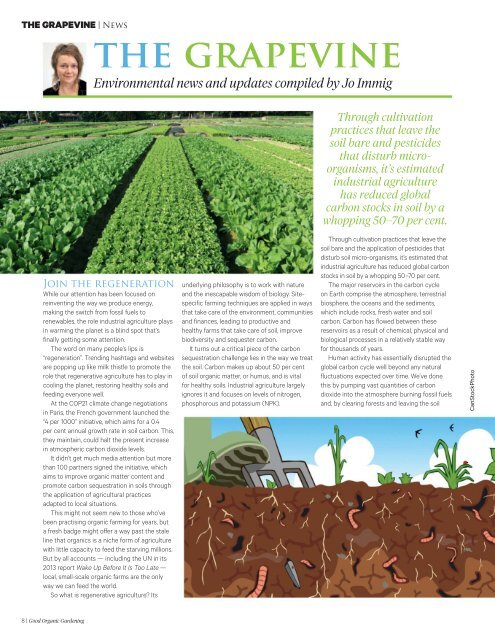3. Good Organic Gardening - May-June 2016 AvxHome.in
3. Good Organic Gardening - May-June 2016 AvxHome.in
3. Good Organic Gardening - May-June 2016 AvxHome.in
You also want an ePaper? Increase the reach of your titles
YUMPU automatically turns print PDFs into web optimized ePapers that Google loves.
THE GRAPEVINE | News<br />
the grapev<strong>in</strong>e<br />
Environmental news and updates compiled by Jo Immig<br />
Through cultivation<br />
practices that leave the<br />
soil bare and pesticides<br />
that disturb microorganisms,<br />
it’s estimated<br />
<strong>in</strong>dustrial agriculture<br />
has reduced global<br />
carbon stocks <strong>in</strong> soil by a<br />
whopp<strong>in</strong>g 50–70 per cent.<br />
Jo<strong>in</strong> the regeneration<br />
While our attention has been focused on<br />
re<strong>in</strong>vent<strong>in</strong>g the way we produce energy,<br />
mak<strong>in</strong>g the switch from fossil fuels to<br />
renewables, the role <strong>in</strong>dustrial agriculture plays<br />
<strong>in</strong> warm<strong>in</strong>g the planet is a bl<strong>in</strong>d spot that’s<br />
f<strong>in</strong>ally gett<strong>in</strong>g some attention.<br />
The word on many people’s lips is<br />
“regeneration”. Trend<strong>in</strong>g hashtags and websites<br />
are popp<strong>in</strong>g up like milk thistle to promote the<br />
role that regenerative agriculture has to play <strong>in</strong><br />
cool<strong>in</strong>g the planet, restor<strong>in</strong>g healthy soils and<br />
feed<strong>in</strong>g everyone well.<br />
At the COP21 climate change negotiations<br />
<strong>in</strong> Paris, the French government launched the<br />
“4 per 1000” <strong>in</strong>itiative, which aims for a 0.4<br />
per cent annual growth rate <strong>in</strong> soil carbon. This,<br />
they ma<strong>in</strong>ta<strong>in</strong>, could halt the present <strong>in</strong>crease<br />
<strong>in</strong> atmospheric carbon dioxide levels.<br />
It didn’t get much media attention but more<br />
than 100 partners signed the <strong>in</strong>itiative, which<br />
aims to improve organic matter content and<br />
promote carbon sequestration <strong>in</strong> soils through<br />
the application of agricultural practices<br />
adapted to local situations.<br />
This might not seem new to those who’ve<br />
been practis<strong>in</strong>g organic farm<strong>in</strong>g for years, but<br />
a fresh badge might offer a way past the stale<br />
l<strong>in</strong>e that organics is a niche form of agriculture<br />
with little capacity to feed the starv<strong>in</strong>g millions.<br />
But by all accounts — <strong>in</strong>clud<strong>in</strong>g the UN <strong>in</strong> its<br />
2013 report Wake Up Before It Is Too Late —<br />
local, small-scale organic farms are the only<br />
way we can feed the world.<br />
So what is regenerative agriculture? Its<br />
underly<strong>in</strong>g philosophy is to work with nature<br />
and the <strong>in</strong>escapable wisdom of biology. Sitespecific<br />
farm<strong>in</strong>g techniques are applied <strong>in</strong> ways<br />
that take care of the environment, communities<br />
and f<strong>in</strong>ances, lead<strong>in</strong>g to productive and<br />
healthy farms that take care of soil, improve<br />
biodiversity and sequester carbon.<br />
It turns out a critical piece of the carbon<br />
sequestration challenge lies <strong>in</strong> the way we treat<br />
the soil. Carbon makes up about 50 per cent<br />
of soil organic matter, or humus, and is vital<br />
for healthy soils. Industrial agriculture largely<br />
ignores it and focuses on levels of nitrogen,<br />
phosphorous and potassium (NPK).<br />
Through cultivation practices that leave the<br />
soil bare and the application of pesticides that<br />
disturb soil micro-organisms, it’s estimated that<br />
<strong>in</strong>dustrial agriculture has reduced global carbon<br />
stocks <strong>in</strong> soil by a whopp<strong>in</strong>g 50–70 per cent.<br />
The major reservoirs <strong>in</strong> the carbon cycle<br />
on Earth comprise the atmosphere, terrestrial<br />
biosphere, the oceans and the sediments,<br />
which <strong>in</strong>clude rocks, fresh water and soil<br />
carbon. Carbon has flowed between these<br />
reservoirs as a result of chemical, physical and<br />
biological processes <strong>in</strong> a relatively stable way<br />
for thousands of years.<br />
Human activity has essentially disrupted the<br />
global carbon cycle well beyond any natural<br />
fluctuations expected over time. We’ve done<br />
this by pump<strong>in</strong>g vast quantities of carbon<br />
dioxide <strong>in</strong>to the atmosphere burn<strong>in</strong>g fossil fuels<br />
and, by clear<strong>in</strong>g forests and leav<strong>in</strong>g the soil<br />
CanStockPhoto<br />
8 | <strong>Good</strong> <strong>Organic</strong> <strong>Garden<strong>in</strong>g</strong>
















